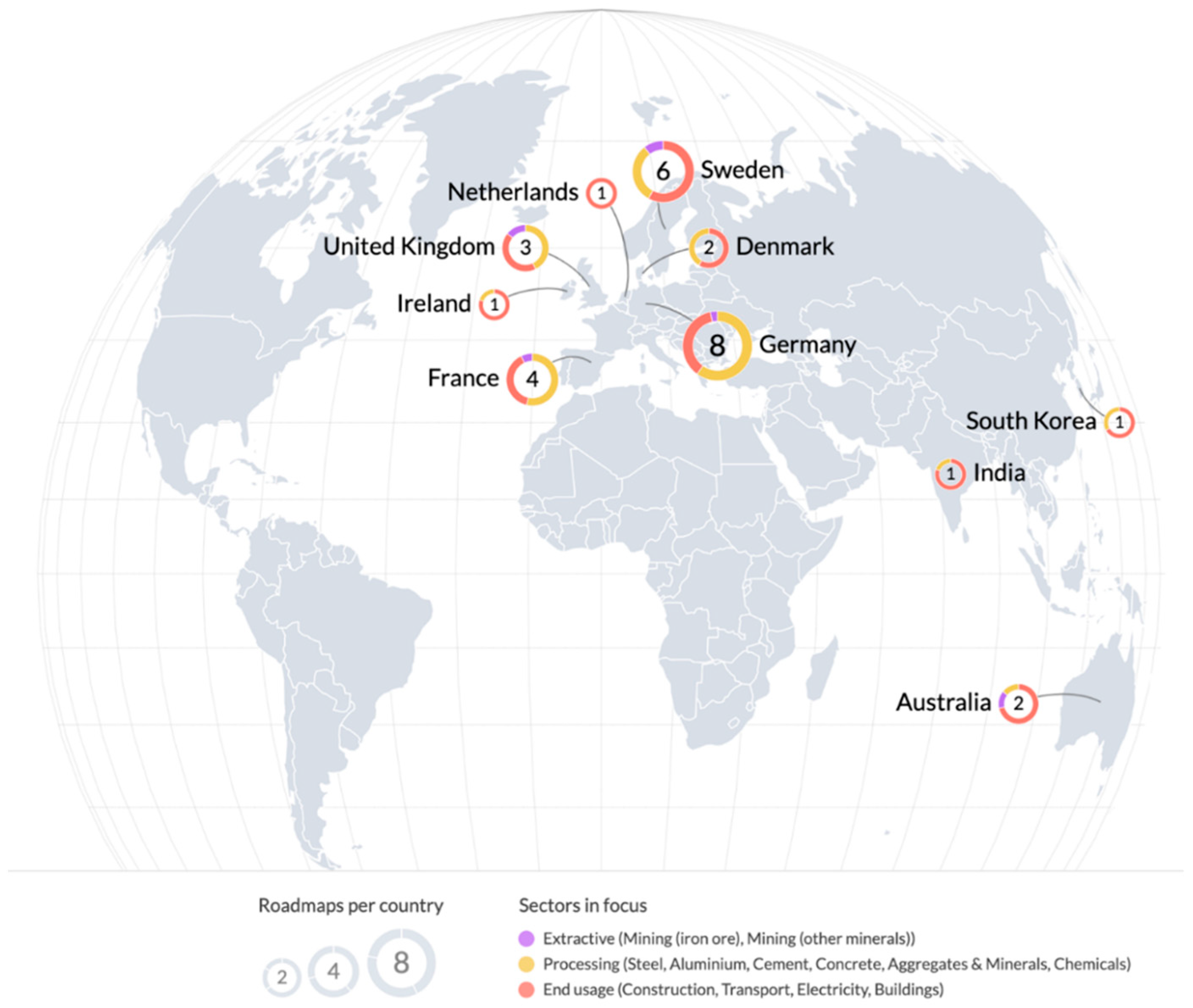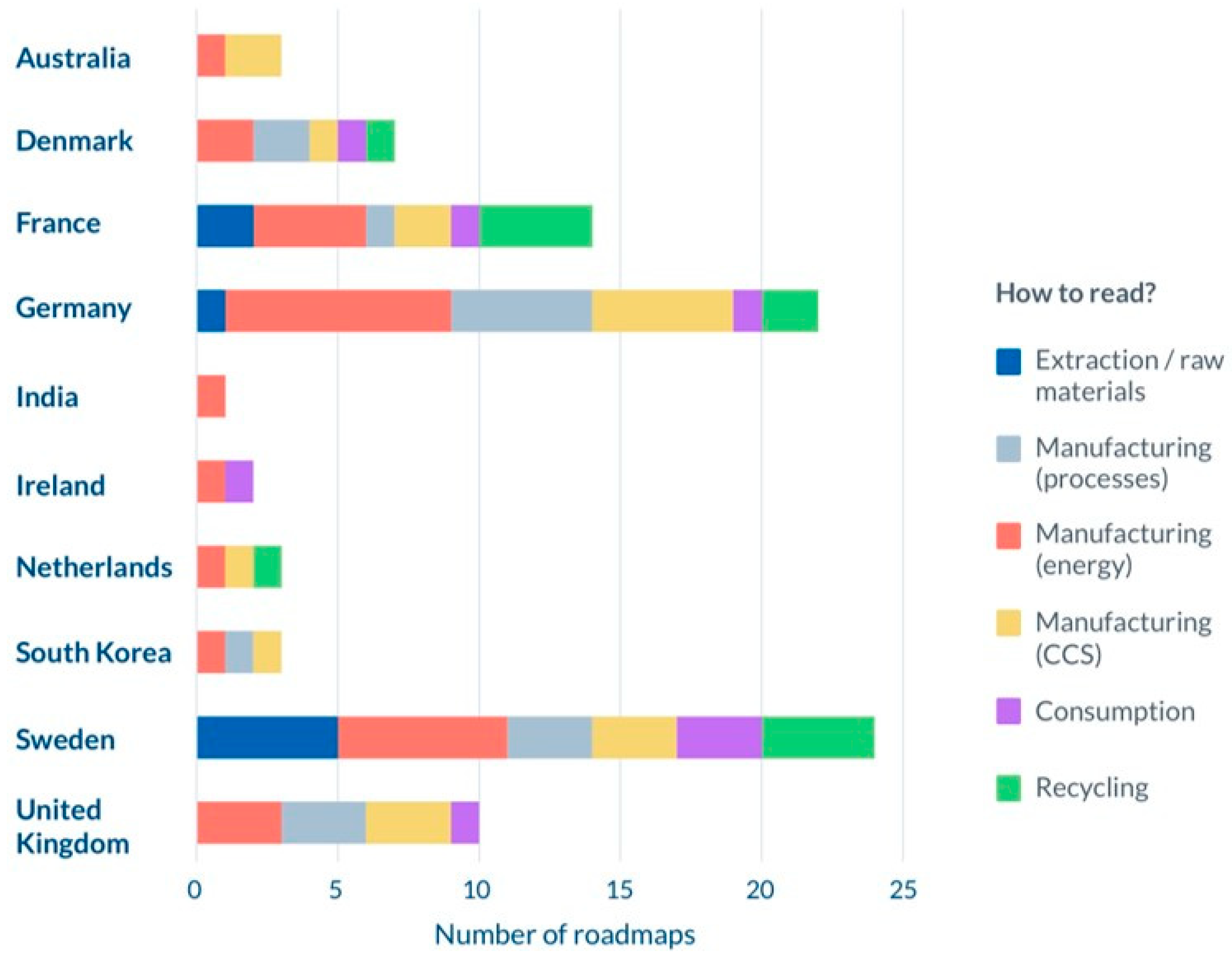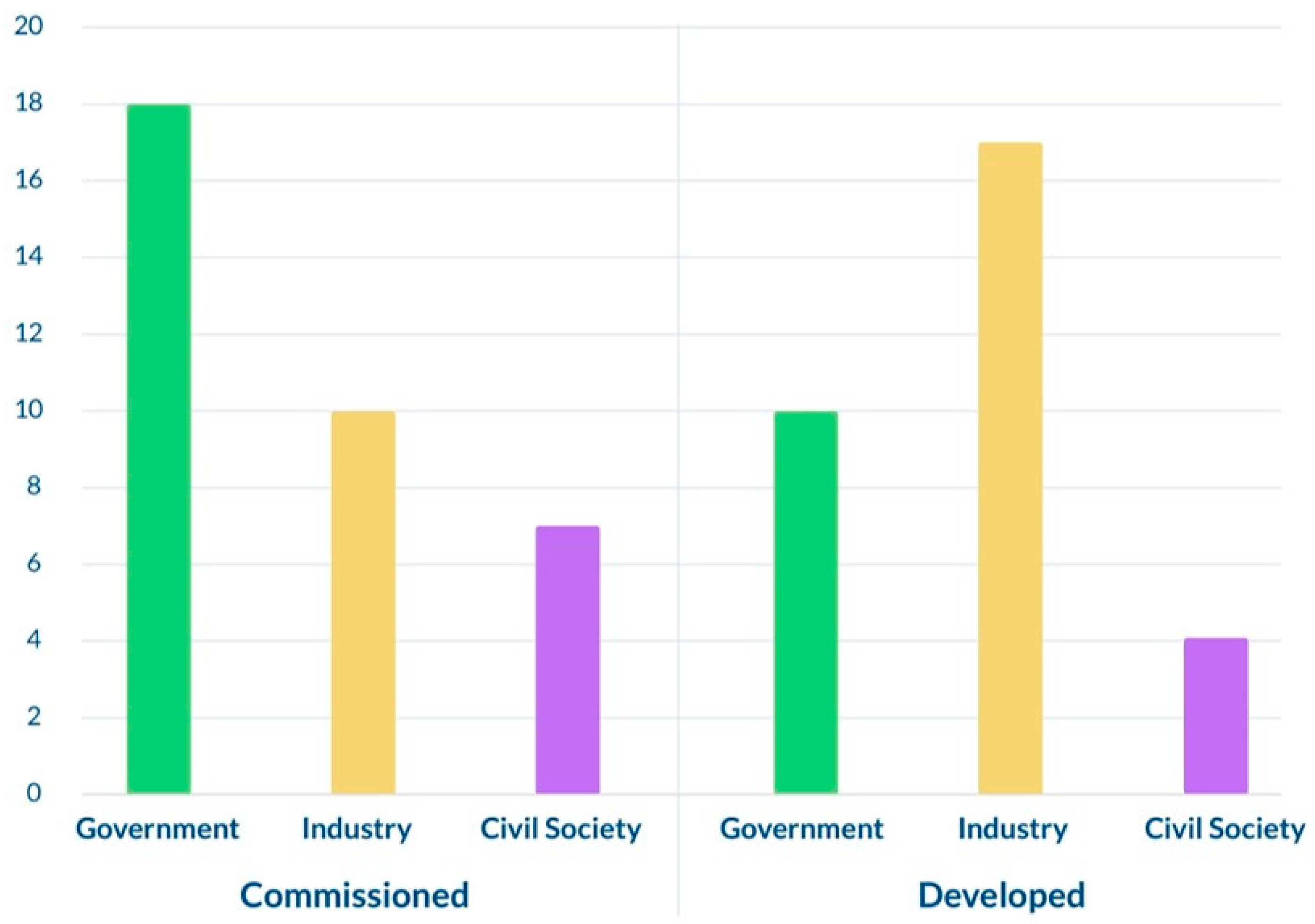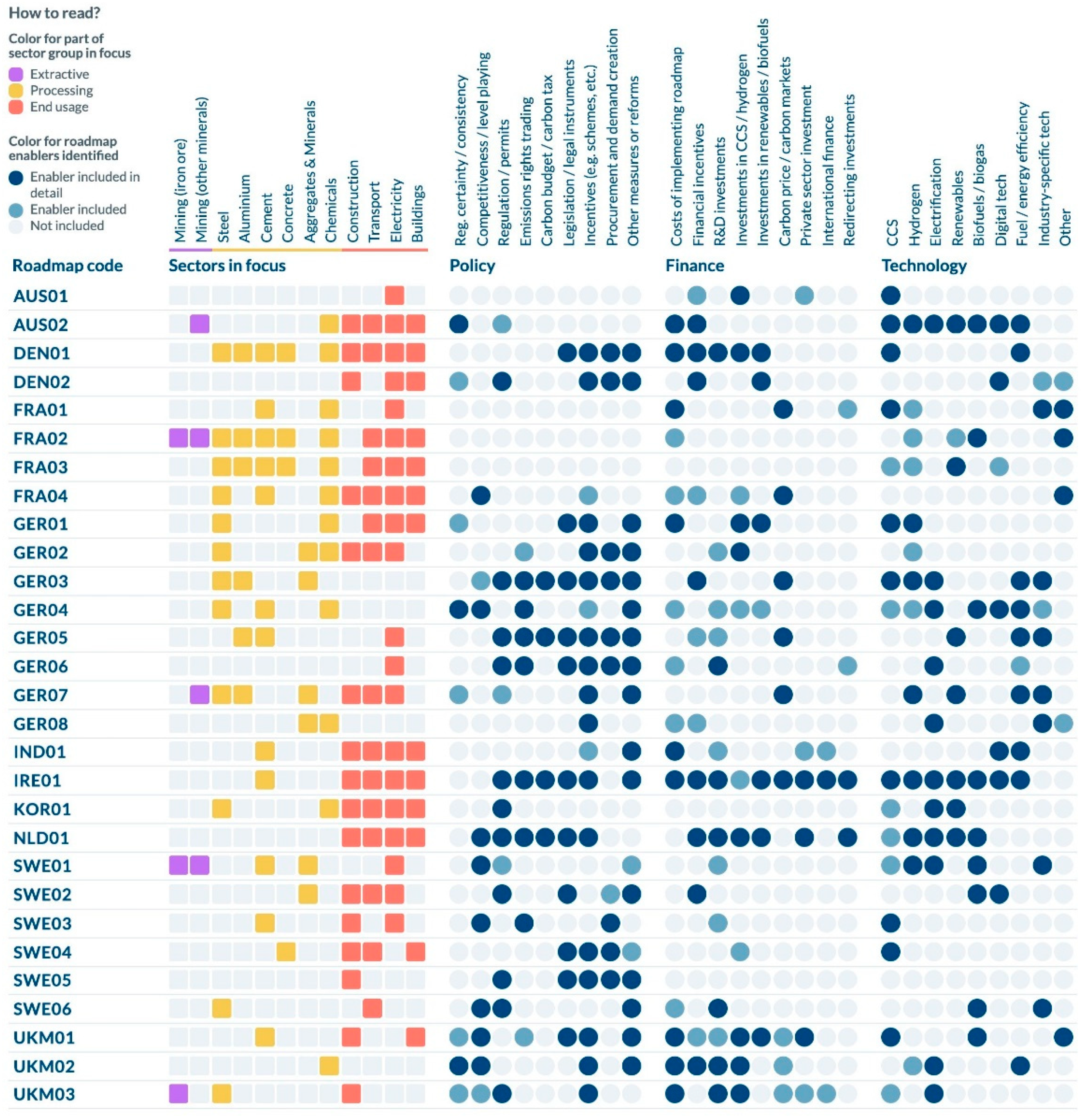Toward Climate-Neutral Heavy Industry: An Analysis of Industry Transition Roadmaps
Abstract
1. Introduction
2. Materials and Methods
2.1. Data Collection
2.2. Data Analysis (Coding Framework)
- Decarbonization visions and emission target;
- Actors commissioning and developing the roadmaps;
- Industries and sectors targeted in the roadmap.
- Policy levers and enablers;
- Financing needs and options;
- Technology demands and innovations.
3. Results
3.1. Summary
3.2. Analysis of Roadmap Requirements
4. Discussion
4.1. Breadth and Depth of Industry Transition Roadmaps
4.2. Opportunities for Joint Learning and Collaboration on Industry Transition
4.3. Limitations of Roadmap Analysis
5. Conclusions
Author Contributions
Funding
Institutional Review Board Statement
Informed Consent Statement
Data Availability Statement
Conflicts of Interest
References
- Fischedick, M.; Roy, J.; Abdel-Aziz, A.; Acquaye, A.; Allwood, J.M.; Ceron, J.-P.; Geng, Y.; Kheshgi, H.; Lanza, A.; Perczyk, D.; et al. Chapter 10: Industry. In IPCC AR5 WG3; Intergovernmental Panel on Climate Change: Geneva, Switzerland, 2014. [Google Scholar]
- IEA. Tracking Industry 2020; International Energy Agency (IEA): Paris, France, 2020; Available online: https://www.iea.org/reports/tracking-industry-2020 (accessed on 19 March 2021).
- IPCC. Global Warming of 1.5 °C: An IPCC Special Report on the Impacts of Global Warming of 1.5 °C above Pre-Industrial Levels and Related Global Greenhouse Gas Emission Pathways, in the Context of Strengthening the Global Response to the Threat of Climate Change, Sustainable Development, and Efforts to Eradicate Poverty; Intergovernmental Panel on Climate Change: Geneva, Switzerland, 2019. [Google Scholar]
- Energy Transitions Commission. Mission Possible: Reaching Net-Zero Carbon Emissions from Harder-To-Abate Sectors by Mid-Century; Energy Transition Commission: London, UK, 2018. [Google Scholar]
- Chen, J.-M.; Yu, B.; Wei, Y.-M. CO2 emissions accounting for the chemical industry: An empirical analysis for China. Nat. Hazards 2019, 99, 1327–1343. [Google Scholar] [CrossRef]
- Greenhouse Gas Protocol. Available online: https://ghgprotocol.org/ (accessed on 19 March 2021).
- Lechtenböhmer, S.; Nilsson, L.J.; Åhman, M.; Schneider, C. Decarbonising the energy intensive basic materials industry through electrification—Implications for future EU electricity demand. Energy 2016, 115, 1623–1631. [Google Scholar] [CrossRef]
- McKinsey & Company. Energy Transition: Mission (Im)Possible for Industry? A Dutch Example for Decarbonization; McKinsey & Company: New York, NY, USA, 2017. [Google Scholar]
- U.S. Environmental Protection Agency. Industrial Processes and Product Use. In Inventory of U.S. Green–House Gas Emissions and Sinks: 1990–2018; U.S. Environmental Protection Agency: Washington, DC, USA, 2020. [Google Scholar]
- IEA. Technology Roadmap—Low-Carbon Transition in the Cement Industry; IEA: Paris, France, 2018. [Google Scholar]
- Allwood, J.M.; Cullen, J.M.; Milford, R.L. Options for Achieving a 50% Cut in Industrial Carbon Emissions by 2050. Environ. Sci. Technol. 2010, 44, 1888–1894. [Google Scholar] [CrossRef]
- European Commission. EU Energy-Intensive Industries’ 2050 Masterplan; European Commissioin: Brussels, Belgium, 2019. [Google Scholar]
- Material Economics. The Circular Economy: A Powerful Force for Climate Mitigation; Material Economics: Stockholm, Sweden, 2018. [Google Scholar]
- Fischedick, M.; Marzinkowski, J.; Winzer, P.; Weigel, M. Techno-economic evaluation of innovative steel production technologies. J. Clean. Prod. 2014, 84, 563–580. [Google Scholar] [CrossRef]
- Bataille, C.; Åhman, M.; Neuhoff, K.; Nilsson, L.J.; Fischedick, M.; Lechtenböhmer, S.; Solano-Rodriquez, B.; Denis-Ryan, A.; Stiebert, S.; Waisman, H.; et al. A review of technology and policy deep decarbonization pathway options for making energy-intensive industry production consistent with the Paris Agreement. J. Clean. Prod. 2018, 187, 960–973. [Google Scholar] [CrossRef]
- Skoczkowski, T.; Verdolini, E.; Bielecki, S.; Kochański, M.; Korczak, K.; Węglarz, A. Technology innovation system analysis of decarbonisation options in the EU steel industry. Energy 2020, 212, 118688. [Google Scholar] [CrossRef] [PubMed]
- Chen, Y.-S.; Chang, C.-H.; Lin, Y.-H. The Determinants of Green Radical and Incremental Innovation Performance: Green Shared Vision, Green Absorptive Capacity, and Green Organizational Ambidexterity. Sustainability 2014, 6, 7787–7806. [Google Scholar] [CrossRef]
- Trianni, A.; Cagno, E.; Worrell, E. Innovation and adoption of energy efficient technologies: An exploratory analysis of Italian primary metal manufacturing SMEs. Energy Policy 2013, 61, 430–440. [Google Scholar] [CrossRef]
- Åhman, M.; Nikoleris, A.; Wyns, T. Decarbonizing industry: Emerging roadmaps point to major need for financing radical innovation. Carbon Manag. 2013, 4, 5–7. [Google Scholar] [CrossRef][Green Version]
- Bataille, C.G.F. Physical and policy pathways to net-zero emissions industry. WIREs Clim. Chang. 2020, 11, e633. [Google Scholar] [CrossRef]
- Rissman, J.; Bataille, C.; Masanet, E.; Aden, N.; Morrow, W.R.; Zhou, N.; Elliott, N.; Dell, R.; Heeren, N.; Huckestein, B.; et al. Technologies and policies to decarbonize global industry: Review and assessment of mitigation drivers through 2070. Appl. Energy 2020, 266, 114848. [Google Scholar] [CrossRef]
- Cherp, A.; Vinichenko, V.; Jewell, J.; Brutschin, E.; Sovacool, B. Integrating techno-economic, socio-technical and political perspectives on national energy transitions: A meta-theoretical framework. Energy Res. Soc. Sci. 2018, 37, 175–190. [Google Scholar] [CrossRef]
- Janipour, Z.; de Nooij, R.; Scholten, P.; Huijbregts, M.A.J.; de Coninck, H. What are sources of carbon lock-in in energy-intensive industry? A case study into Dutch chemicals production. Energy Res. Soc. Sci. 2020, 60, 101320. [Google Scholar] [CrossRef]
- Foxon, T.J. A coevolutionary framework for analysing a transition to a sustainable low carbon economy. Ecol. Econ. 2011, 70, 2258–2267. [Google Scholar] [CrossRef]
- Geels, F. Co-evolution of technology and society: The transition in water supply and personal hygiene in the Netherlands (1850–1930)—A case study in multi-level perspective. Technol. Soc. 2005, 27, 363–397. [Google Scholar] [CrossRef]
- Geels, F.W.; Schot, J. Typology of sociotechnical transition pathways. Res. Policy 2007, 36, 399–417. [Google Scholar] [CrossRef]
- Köhler, J.; Geels, F.W.; Kern, F.; Markard, J.; Onsongo, E.; Wieczorek, A.; Alkemade, F.; Avelino, F.; Bergek, A.; Boons, F.; et al. An agenda for sustainability transitions research: State of the art and future directions. Environ. Innov. Soc. Transit. 2019, 31, 1–32. [Google Scholar] [CrossRef]
- O’Brien, K. Is the 1.5 °C target possible? Exploring the three spheres of transformation. Curr. Opin. Environ. Sustain. 2018, 31, 153–160. [Google Scholar] [CrossRef]
- Rosenbloom, D. Pathways: An emerging concept for the theory and governance of low-carbon transitions. Glob. Environ. Chang. 2017, 43, 37–50. [Google Scholar] [CrossRef]
- Lieu, J.; Sorman, A.H.; Johnson, O.W.; Virla, L.D.; Resurrección, B.P. Three sides to every story: Gender perspectives in energy transition pathways in Canada, Kenya and Spain. Energy Res. Soc. Sci. 2020, 68, 101550. [Google Scholar] [CrossRef]
- Turnheim, B.; Berkhout, F.; Geels, F.; Hof, A.; McMeekin, A.; Nykvist, B.; van Vuuren, D. Evaluating sustainability transitions pathways: Bridging analytical approaches to address governance challenges. Glob. Environ. Chang. 2015, 35, 239–253. [Google Scholar] [CrossRef]
- McDowall, W.; Eames, M. Forecasts, scenarios, visions, backcasts and roadmaps to the hydrogen economy: A review of the hydrogen futures literature. Energy Policy 2006, 34, 1236–1250. [Google Scholar] [CrossRef]
- Saritas, O.; Aylen, J. Using scenarios for roadmapping: The case of clean production. Technol. Forecast. Soc. Chang. 2010, 77, 1061–1075. [Google Scholar] [CrossRef]
- Willyard, C.H.; McClees, C.W. Motorola’s Technology Roadmap Process. Res. Manag. 1987, 30, 13–19. [Google Scholar] [CrossRef]
- Phaal, R.; Farrukh, C.J.P.; Probert, D.R. Technology roadmapping—A planning framework for evolution and revolution. Technol. Forecast. Soc. Chang. 2004, 71, 5–26. [Google Scholar] [CrossRef]
- McDowall, W. Technology roadmaps for transition management: The case of hydrogen energy. Technol. Forecast. Soc. Chang. 2012, 79, 530–542. [Google Scholar] [CrossRef]
- IEA. Aligning Investment and Innovation in Heavy Industries to Accelerate the Transition to Net-Zero Emissions; International Energy Agency (IEA): Paris, France, 2020; Available online: https://www.iea.org/commentaries/aligning-investment-and-innovation-in-heavy-industries-to-accelerate-the-transition-to-net-zero-emissions (accessed on 19 March 2021).
- Meckling, J.; Sterner, T.; Wagner, G. Policy sequencing toward decarbonization. Nat. Energy 2017, 2, 918–922. [Google Scholar] [CrossRef]
- Eames, M.; Mcdowall, W.; Hodson, M.; Marvin, S. Negotiating contested visions and place-specific expectations of the hydrogen economy. Technol. Anal. Strateg. Manag. 2006, 18, 361–374. [Google Scholar] [CrossRef]
- Mission Innovation. Available online: http://mission-innovation.net/ (accessed on 19 March 2021).
- Mission Possible Partnership. Available online: https://missionpossiblepartnership.org/ (accessed on 19 March 2021).
- Industry Transition Platform. Available online: https://www.theclimategroup.org/industry-transition-platform (accessed on 19 March 2021).
- Leadership Group for Industry Transition. Available online: https://www.industrytransition.org/ (accessed on 19 March 2021).
- Industry Transition Tracker. Available online: https://www.industrytransition.org/industry-transition-tracker/ (accessed on 19 March 2021).
- Talebian, S.; Johnson, O. What Are Industry Transition Roadmaps? LeadIT Brief; Leadership Group for Industry Transition (LeadIT): Stockholm, Sweden, 2020; Available online: https://www.industrytransition.org/insights/what-are-industry-transition-roadmaps/ (accessed on 19 March 2021).
- Abson, D.J.; Fischer, J.; Leventon, J.; Newig, J.; Schomerus, T.; Vilsmaier, U.; Von Wehrden, H.; Abernethy, P.; Ives, C.D.; Jager, N.W. Leverage points for sustainability transformation. AMBIO 2017, 46, 30–39. [Google Scholar] [CrossRef]
- Otto, I.M.; Donges, J.F.; Cremades, R.; Bhowmik, A.; Hewitt, R.J.; Lucht, W.; Rockström, J.; Allerberger, F.; McCaffrey, M.; Doe, S.S.P.; et al. Social tipping dynamics for stabilizing Earth’s climate by 2050. Proc. Natl. Acad. Sci. USA 2020, 117, 2354–2365. [Google Scholar] [CrossRef] [PubMed]
- Westley, F.; Olsson, P.; Folke, C.; Homer-Dixon, T.; Vredenburg, H.; Loorbach, D.; Thompson, J.; Nilsson, M.; Lambin, E.; Sendzimir, J.; et al. Tipping Toward Sustainability: Emerging Pathways of Transformation. AMBIO 2011, 40, 762–780. [Google Scholar] [CrossRef] [PubMed]
- IPCC. Summary for Policymakers: Global Warming of 1.5 °C. An IPCC Special Report on the Impacts of Global Warming of 1.5 °C above Pre-Industrial Levels and Related Global Greenhouse Gas Emission Pathways, in the Context of Strengthening the Global Response to the Threat of Climate Change, Sustainable Development, and Efforts to Eradicate Poverty; World Meteorological Organization: Geneva, Switzerland, 2018. [Google Scholar]
- Allwood, J.M.; Ashby, M.F.; Gutowski, T.G.; Worrell, E. Material efficiency: Providing material services with less material production. Philos. Trans. R. Soc. Math. Phys. Eng. Sci. 2013, 371, 20120496. [Google Scholar] [CrossRef]
- Blythe, J.; Silver, J.; Evans, L.; Armitage, D.; Bennett, N.J.; Moore, M.-L.; Morrison, T.H.; Brown, K. The Dark Side of Transformation: Latent Risks in Contemporary Sustainability Discourse. Antipode 2018, 50, 1206–1223. [Google Scholar] [CrossRef]
- Scordato, L.; Klitkou, A.; Tartiu, V.E.; Coenen, L. Policy mixes for the sustainability transition of the pulp and paper industry in Sweden. J. Clean. Prod. 2018, 183, 1216–1227. [Google Scholar] [CrossRef]
- Axsen, J.; Plötz, P.; Wolinetz, M. Crafting strong, integrated policy mixes for deep CO2 mitigation in road transport. Nat. Clim. Chang. 2020, 10, 809–818. [Google Scholar] [CrossRef]
- Ekvall, T.; Hirschnitz-Garbers, M.; Eboli, F.; Śniegocki, A. A Systemic and Systematic Approach to the Development of a Policy Mix for Material Resource Efficiency. Sustainability 2016, 8, 373. [Google Scholar] [CrossRef]
- Nykvist, B.; Maltais, A.; Olsson, O. Financing the Decarbonisation of Heavy Industry Sectors in Sweden; Stockholm Environment Institute: Stockholm, Sweden, 2020. [Google Scholar] [CrossRef]
- Habert, G.; Miller, S.A.; John, V.M.; Provis, J.L.; Favier, A.; Horvath, A.; Scrivener, K.L. Environmental impacts and decarbonization strategies in the cement and concrete industries. Nat. Rev. Earth Environ. 2020, 1, 559–573. [Google Scholar] [CrossRef]
- OECD. Regions in Industrial Transition: Policies for People and Places; OECD: Paris, France, 2019; ISBN 978-92-64-80468-5. [Google Scholar] [CrossRef]
- Henry, M.S.; Bazilian, M.D.; Markuson, C. Just transitions: Histories and futures in a post-COVID world. Energy Res. Soc. Sci. 2020, 68, 101668. [Google Scholar] [CrossRef] [PubMed]




| Term | Definition | Key Search Words |
|---|---|---|
| Industry transition | Industry transition refers to low-carbon solutions for industries, and decarbonization pathways for industry sectors to implement carbon emission mitigation measures. | Industry transition Low-carbon industry Industry mitigation Industry decarbonization |
| Roadmap | Roadmaps are long-range strategic plans setting out actionable measures on innovation, policy, public–private partnership, and finance required to transform industries. | Roadmap Pathway Strategy Strategic plan Climate action for industry |
| Harder-to-abate industries | Harder-to-abate sectors are economic sectors with relatively higher abatement costs than the rest of the economy. For the purposes of our analysis, these include heavy industries (e.g., cement, steel, chemicals) but not heavy-duty transport (heavy-duty road transport, shipping, aviation). | Heavy industry Hard-to-abate industry/sector Harder-to-abate industry/sector Cement Steel Plastic Chemicals Mining Aluminum Construction Chemicals |
| Visions | Visions are elaborations of a desirable future, emphasizing a pre-determined goal or target in the future. Visions are often the end goal of decarbonization pathways and roadmaps (e.g., a set emission target, net-zero by 2050, etc.). Visions are also sometimes referred to as normative scenarios. | Decarbonization vision/target/goal/scenario Low-carbon vision/target/goal/scenario Carbon-neutral vision/target/goal/scenario Net-zero Carbon emission neutrality |
| Policy for industry transition | Any national scale laws, legislation, regulations, etc. supporting industry transition could also be laying out the vision and steps and measures to take toward industry transitions. In this sense, these policy documents could be equivalent to our definition of roadmaps. | Decarbonization policy Energy-efficiency policy Industry transition policy Climate policy Industry policy |
| ID # | Country | Title of Roadmap | Publication Year | Emission Reduction Target % |
|---|---|---|---|---|
| AUS01 | Australia | A CCS Roadmap for Australia | 2017 | Not specified |
| AUS02 | Australia | Australia’s Technology Investment Roadmap | 2020 | Not specified |
| DEN01 | Denmark | Energy-Intensive Industry | 2020 | 70% by 2030 (1990 baseline) |
| DEN02 | Denmark | Recommendations to the government from the Climate Partnership for construction sector | 2020 | Not specified |
| FRA01 | France | National Low-Carbon Strategy Project | 2018 | 100% |
| FRA02 | France | NégaWatt Scenario | 2017 | 100% |
| FRA03 | France | Update of ADEME 2035–2050 Energy–Climate Scenario | 2017 | 100% |
| FRA04 | France | ZEN 2050—Imagining and building a carbon-neutral France | 2019 | 100% |
| GER01 | Germany | An industry roadmap for the market introduction of renewable and decarbonised gases | 2019 | Not specified |
| GER02 | Germany | Eine Wasserstoff-Roadmap für Deutschland (A hydrogen roadmap for Germany) | 2019 | 80% by 2030 (1990 baseline) |
| GER03 | Germany | Klimaneutrale Industrie (Climate neutral industry) | 2019 | 100% |
| GER04 | Germany | Klimapfade für Deutschland (Climate paths for Germany) | 2018 | 95% by 2050 (2015 baseline) |
| GER05 | Germany | Klimaschutz in der Beton- und Zementindustrie (Climate protection in the concrete and cement industry) | 2019 | 100% |
| GER06 | Germany | Klimaschutz in der Industrie (Climate protection in industry) | 2019 | 100% |
| GER07 | Germany | Resource-Efficient Pathways toward Greenhouse-Gas Neutrality—RESCUE | 2019 | 96% by 2050 (1990 baseline) |
| GER08 | Germany | Roadmap Chemie 2050 (Working toward a greenhouse gas neutral chemical industry in Germany) | 2019 | 100% |
| IND01 | India | Indian Cement Sector SDG Roadmap | 2019 | Not specified |
| IRE01 | Ireland | Climate Action Plan 2019 | 2019 | 100% |
| KOR01 | SouthKorea | Basic National Roadmap for Greenhouse Gas Reductions by 2030 | 2018 | 37% by 2030 (2030 BAU trajectory baseline from 2020) |
| NLD01 | Netherlands | National Climate Agreement | 2019 | 49% by 2030 (1990 baseline) |
| SWE01 | Sweden | Roadmap for Long-Term Competitiveness and a Fossil-Free Mining and Minerals Industry | 2018 | 100% |
| SWE02 | Sweden | Roadmap: The Aggregates Industry | 2018 | 100% |
| SWE03 | Sweden | Roadmap: The Cement Industry | 2018 | 100% |
| SWE04 | Sweden | Roadmap: The Concrete Industry | 2018 | 100% |
| SWE05 | Sweden | Roadmap: The Construction and Civil Engineering Sector | 2018 | 100% |
| SWE06 | Sweden | Roadmap: The Steel Industry | 2018 | 100% |
| UKM01 | UK | Industrial Decarbonization & Energy Efficiency Roadmaps to 2050: Cement | 2015 | 80% by 2050 (1990 baseline) |
| UKM02 | UK | Industrial Decarbonization & Energy Efficiency Roadmaps to 2050: Chemicals | 2015 | 80% by 2050 (1990 baseline) |
| UKM03 | UK | Industrial Decarbonization & Energy Efficiency Roadmaps to 2050: Iron and Steel | 2015 | 80% by 2050 (1990 baseline) |
| Requirement | Category | Citation Frequency | Overall Frequency Ranking | Frequency Ranking within Category |
|---|---|---|---|---|
| Incentives (non-financial) | Policy | 35 | 1 | 1 |
| Other measures or reforms | Policy | 34 | 2 | 2 |
| CCS | Technology | 28 | 3 | 1 |
| Regulations and permits | Policy | 25 | 4 | 3 |
| Costs of implementation | Finance | 24 | 5 | 1 |
| Legislation/legal instruments | Policy | 22 | =7 | 4 |
| Electrification | Technology | 22 | =7 | 2 |
| Financial incentives | Finance | 21 | =9 | =3 |
| R&D investments | Finance | 21 | =9 | =3 |
Publisher’s Note: MDPI stays neutral with regard to jurisdictional claims in published maps and institutional affiliations. |
© 2021 by the authors. Licensee MDPI, Basel, Switzerland. This article is an open access article distributed under the terms and conditions of the Creative Commons Attribution (CC BY) license (https://creativecommons.org/licenses/by/4.0/).
Share and Cite
Johnson, O.W.; Mete, G.; Sanchez, F.; Shawoo, Z.; Talebian, S. Toward Climate-Neutral Heavy Industry: An Analysis of Industry Transition Roadmaps. Appl. Sci. 2021, 11, 5375. https://doi.org/10.3390/app11125375
Johnson OW, Mete G, Sanchez F, Shawoo Z, Talebian S. Toward Climate-Neutral Heavy Industry: An Analysis of Industry Transition Roadmaps. Applied Sciences. 2021; 11(12):5375. https://doi.org/10.3390/app11125375
Chicago/Turabian StyleJohnson, Oliver W., Gökçe Mete, Felipe Sanchez, Zoha Shawoo, and Sara Talebian. 2021. "Toward Climate-Neutral Heavy Industry: An Analysis of Industry Transition Roadmaps" Applied Sciences 11, no. 12: 5375. https://doi.org/10.3390/app11125375
APA StyleJohnson, O. W., Mete, G., Sanchez, F., Shawoo, Z., & Talebian, S. (2021). Toward Climate-Neutral Heavy Industry: An Analysis of Industry Transition Roadmaps. Applied Sciences, 11(12), 5375. https://doi.org/10.3390/app11125375





